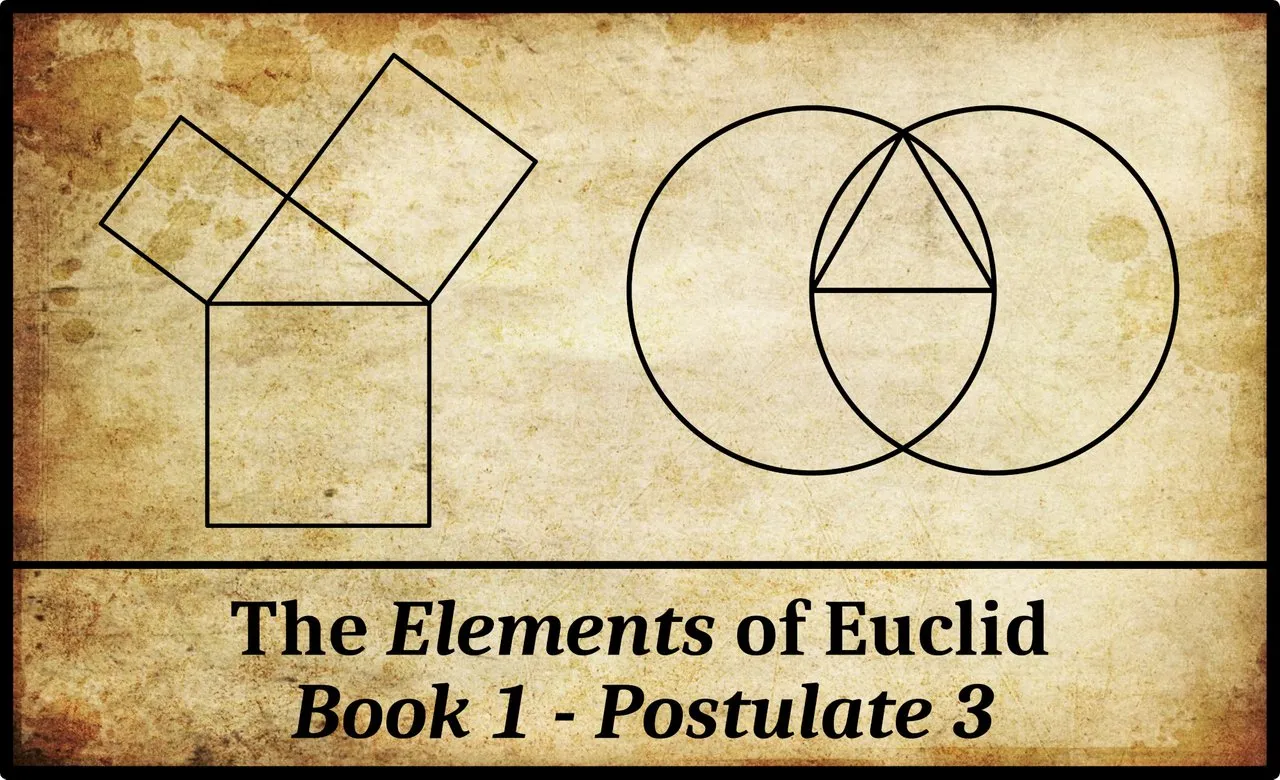
In Book 1 of Euclid’s Elements, Postulate 3 reads (Fitzpatrick 7):
| Greek | English |
|---|---|
| γʹ. Καὶ παντὶ κέντρῳ καὶ διαστήματι κύκλον γράφεσθαι. | 3. And to draw a circle with any center and radius. |
As we saw in a previous article, the verb Ἠιτήσθω [Ēitēsthō], Let it have been postulated, is understood to apply to all five postulates.
To Draw
In his 1826 edition of the Elements, Ernst Ferdinand August has γράψαι [grapsai] instead of γράφεσθαι [graphesthai], which is found in all the other editions I consulted. As Heiberg points out, August took this from Proclus’ Commentary on the First Book of Euclid’s Elements (Heiberg 9, Morrow 145, Friedlein 185). The former is the aorist active infinitive of the verb γράφω [graphō], I draw. This translates as to draw. The latter is the present middle infinitive, which also translates as to draw. The distinction between the two is subtle:
The aorist active infinitive implies a single, discrete, completed action.
The present middle infinitive implies that the action is being carried out for oneself or for one’s own use (middle voice) and is in some sense incomplete. That is to say, it is an ongoing or progressive action, or—as is the case here—it is an action that can be repeated indefinitely.
In Ancient Greek, the distinction between the aorist infinitive and the present infinitive is one of aspect rather than tense. Thomas Heath comments:
In this case Euclid’s text has the passive of the verb: “a circle can be drawn”; Proclus however has the active γράψαι as Euclid has in the first two Postulates. (Heath 199)
In the first postulate, Euclid has ἀγαγεῖν [agagein], to draw, which is also an aorist active infinitive (second aorist active infinitive, to be precise). Why does he use two different verbs to express the same concept? According to Liddell & Scott’s A Greek-English Lexicon, ἄγω is used specifically for drawing lines, while γράφω is more general in its application:

Radius
In this definition Euclid uses the term διάστημα [diastēma] for the radius of a circle. Curiously, he did not define this term in his definitions, though he did define the term διάμετρος [diametros], diameter in Definition 17. Throughout the Elements Euclid regularly uses the form διαστήματι to mean with radius. On a number of occasions he also uses the expression ἐκ τοῦ κέντρου τοῦ κύκλου [ek tou kentrou tou kuklou], from the centre of the circle to denote radius—and a similar expression when referring to the radius of a sphere. The primary meaning of διάστημα is an interval. Liddell & Scott do not even mention radius in their entry:

Like Henry Billingsley, who published the first English translation of the Elements in 1570, Thomas Heath translates διαστήματι as distance.
Distance, διαστήματι. This word, meaning “distance” quite generally (cf. Arist. Metaph. 1055 a 9 “it is between extremities that distance is greatest,” ibid. 1056 a 36 “things which have something between them, that is, a certain distance”), and also “distance” in the sense of “dimension” (as in “space has three dimensions, length, breadth and depth,” Arist. Physics IV. I, 209 a 4), was the regular word used for describing a circle with a certain radius, the idea being that each point of the circumference was at that distance from the centre (cf. Arist Meteorologica III. 5, 376 b 8: “if a circle be drawn ... with distance MII”). The Greeks had no word corresponding to radius: if they had to express it, they said “(straight lines) drawn from the centre” (αἱ ἐκ τῶν κέντρων, Eucl. III. Def. 1 and Prop. 26; Meteorologica II. 5, 362 b I has the full phrase αἱ ἐκ τοῦ κέντρου αὐτῆς ἀγόμεναι). (Heath 199)
Any Centre and Any Radius
When Euclid says παντὶ κέντρῳ καὶ διαστήματι [panti kentrōi kai diastēmati], with any center and radius, the adjective παντὶ, any, applies to both center and radius. This is clearly understood by several of Euclid’s translators who express this explicitly in their translations:
| Translator | Translation |
|---|---|
| Billingsley (1570) | Vpon any centre and at any distance to describe a circle. |
| Peyrard (1814) | D’un point quelconque, et avec un intervalle quelconque, décrire une circonférence de cercle. |
The Deeper Implications of Postulate 3
While this postulate may be read as simply allowing for the construction of a circle at any point in the Euclidean plane and with any radius, there are serious and deeper implications behind it, which Heath expresses thus:
Mr Frankland observes that it would be remarkable if, unlike Postulates 1 and 2, this Postulate implied merely what it says, that a circle can be drawn with any centre and distance [Frankland 35-37]. We may regard it, if we please, as helping to the complete delineation of the Space which Euclid’s geometry is to investigate formally. The Postulate has the effect of removing any restriction upon the size of the circle. It may (1) be indefinitely small, and this implies that space is continuous, not discrete, with an irreducible minimum distance between contiguous points in it. (2) The circle may be indefinitely large, which implies the fundamental hypothesis of infinitude of space. This last assumed characteristic of space is essential to the proof of I.16, a theorem not universally valid in a space which is unbounded in extent but finite in size. It would however be unsafe to suppose that Euclid foresaw the use to which his Postulate might thus be put, or formulated it with such an intention. (Heath 199-200)

Construction
Although Euclid’s geometry is not constructive, a constructive geometry can be built upon Euclid’s postulates. This geometry is often called Euclidean, or straightedge-and-compass geometry. In this interpretation, the Third Postulate describes the Euclidean compass:
This is the third assumed construction in the Elements. It corresponds to drawing a circle with a compass ... Note that this postulate does not allow for the compass to be moved. The usual way that a compass is used is that it is opened to a given width, then the pivot is placed on the drawing surface, then a circle is drawn as the compass is rotated around the pivot. But this postulate does not allow for transferring distances. It is as if the compass collapses as soon as it’s removed from the plane. Proposition I.2, however, gives a construction for transferring distances. Therefore, the same constructions that can be made with a regular compass can also be made with Euclid’s collapsing compass. (Joyce)
Joyce is referring to the Compass Equivalence Theorem.
And that’s a good place to stop.
References
- Ernst Ferdinand August, Euclidis Elementa, Part 1, Theodor Trautwein, Berlin (1826)
- Henry Billingsley (translator), The Elements of Geometrie of the Most Auncient Philosopher Evclide of Megara, John Day, London (1582)
- Richard Fitzpatrick (translator), Euclid’s Elements of Geometry, University of Texas at Austin, Austin, TX (2008)
- William Barrett Frankland, The First Book of Euclid’s Elements with a Commentary Based Principally upon That of Proclus Diadochus, Cambridge University Press, Cambridge (1905)
- Gottfried Friedlein, Procli Diadochi in Primum Euclidis Elementorum Librum Commentarii, B G Teubner, Leipzig (1873)
- Thomas Little Heath (translator & editor), The Thirteen Books of Euclid’s Elements, Second Edition, Dover Publications, New York (1956)
- Johan Ludvig Heiberg, Heinrich Menge, Euclidis Elementa edidit et Latine interpretatus est I. L. Heiberg, Volumes 1-5, B G Teubner Verlag, Leipzig (1883-1888)
- Henry George Liddell, Robert Scott, A Greek-English Lexicon, Eighth Edition, American Book Company, New York (1901)
- Glenn Raymond Morrow (translator), Proclus: A Commentary on the First Book of Euclid’s Elements, Princeton University Press, Princeton, NJ (1970)
- François Peyrard, Les Œuvres d’Euclide, en Grec, en Latin et en Français, Volumes 1-3, Charles-Frobert Patris, Paris (1814, 1816, 1818)
- Thomas Taylor, The Philosophical and Mathematical Commentaries of Proclus on the First Book of Euclid’s Elements, Volume 1, Volume 2, London (1792)
Image Credits
- Euclid in The School of Athens: Raphael (artist), Stanza della Segnatura, Apostolic Palace, Vatican City, Jean-Pol GRANDMONT (photographer), Public Domain
Online Resources
